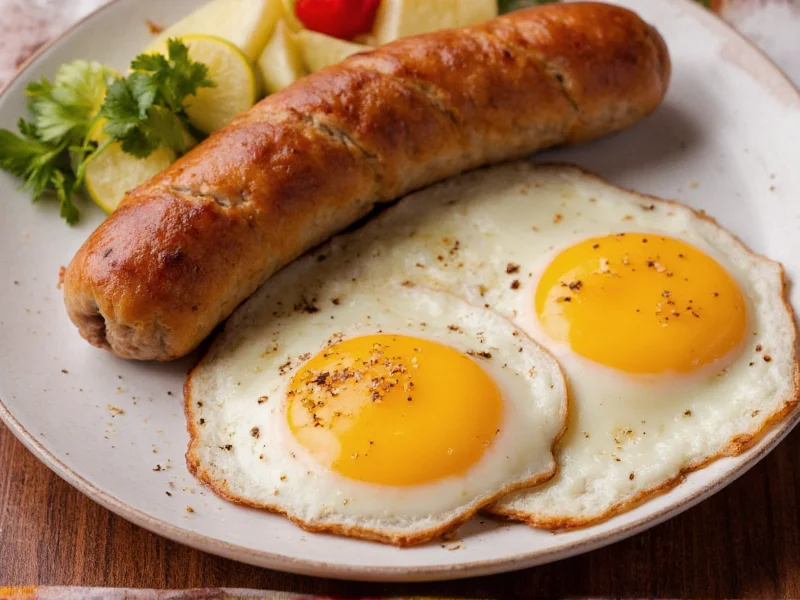Why This Breakfast Sausage Recipe Works
Creating delicious homemade breakfast sausage doesn't require special equipment or hard-to-find ingredients. This straightforward recipe delivers consistent results with minimal effort, making it ideal for busy mornings. Unlike store-bought varieties that often contain preservatives and excessive sodium, this version lets you control exactly what goes into your morning meal.
Essential Ingredients for Flavorful Breakfast Sausage
The magic of great sausage lies in the balance of seasonings. While regional variations exist, this classic breakfast sausage blend hits the perfect sweet-spicy-savory notes that complement eggs and toast beautifully.
| Ingredient | Amount | Key Function |
|---|---|---|
| Ground pork (80% lean) | 1 pound | Base protein with ideal fat content for juiciness |
| Dried sage | 1 teaspoon | Signature breakfast sausage herb |
| Black pepper | 1 teaspoon | Provides gentle heat and complexity |
| Salt | 1 teaspoon | Enhances flavor and helps bind ingredients |
| Dried thyme | 1/2 teaspoon | Adds earthy depth |
| Red pepper flakes | 1/2 teaspoon | Subtle warmth without overpowering heat |
Step-by-Step Cooking Instructions
- Prepare the mixture: In a large bowl, combine ground pork and all seasonings. Use your hands to mix gently until just incorporated—overmixing makes tough sausage.
- Form patties: Divide into 8 equal portions (about 2 ounces each). Shape into 1/2-inch thick patties, making the center slightly thinner than edges to prevent bulging during cooking.
- Preheat skillet: Place cast iron or heavy-bottomed skillet over medium heat for 3-4 minutes until evenly warm.
- Cook sausage: Add patties without crowding the pan. Cook 4-5 minutes per side until golden brown and internal temperature reaches 160°F.
- Rest before serving: Transfer to paper towel-lined plate and let rest 2 minutes to redistribute juices.
Professional Cooking Tips for Best Results
Mastering breakfast sausage requires attention to detail. These expert techniques ensure perfect results every time:
- Temperature matters: Keep ingredients cold until ready to mix—warm fat melts during cooking, resulting in dry sausage
- Avoid overhandling: Mix just until combined; excessive handling compacts the meat
- Don't press patties: Resist flattening while cooking to retain juices
- Use a thermometer: Visual cues can be misleading; 160°F ensures food safety without overcooking
- Resting time: Allows juices to redistribute for maximum tenderness
Delicious Variations to Try
Once you've mastered the basic recipe, experiment with these popular adaptations for different flavor profiles:
- Southern-style: Add 1/4 cup crumbled cooked bacon and 1/2 teaspoon maple syrup to the mixture
- Apple sage: Mix in 1/4 cup finely grated apple and increase sage to 1 1/2 teaspoons
- Spicy chorizo: Substitute 1/4 cup of pork with ground chicken and add 1 teaspoon smoked paprika
- Maple breakfast sausage: Incorporate 2 tablespoons pure maple syrup and reduce salt by 1/4 teaspoon
Serving Suggestions for Complete Morning Meals
Breakfast sausage shines as part of a well-rounded morning meal. Pair your homemade sausage with these complementary elements:
- Classic combination: Two eggs (scrambled or fried), sausage patties, and buttered toast
- Brunch special: Sausage, fluffy pancakes, and fresh berries with maple syrup
- Healthy option: Sausage with avocado slices, sautéed spinach, and whole grain toast
- Breakfast sandwich: Sausage patty, melted cheddar, and egg on an English muffin
Storage and Reheating Instructions
Proper storage maintains quality and safety for future meals:
- Refrigeration: Store cooled sausage in airtight container for up to 4 days
- Freezing: Place patties between parchment paper in freezer bag; keeps for 3 months
- Reheating: Warm in skillet over medium-low heat 2-3 minutes per side or microwave 45-60 seconds
- Food safety: Always reheat to internal temperature of 165°F before serving
Frequently Asked Questions
Can I make breakfast sausage without a skillet?
Yes, you can bake breakfast sausage in the oven at 375°F for 15-18 minutes, turning once halfway through. This method works well for larger batches and produces evenly cooked sausage with less hands-on attention required.
What's the best way to prevent sausage from sticking to the pan?
Preheat your skillet properly before adding sausage. A properly heated cast iron or non-stick pan requires minimal oil—just a light coating of cooking spray or 1/2 teaspoon of oil. Avoid moving patties during the first 2-3 minutes of cooking to allow proper sear formation.
Can I use ground turkey instead of pork for breakfast sausage?
Yes, ground turkey works as a leaner alternative, but you'll need to adjust the recipe. Add 2 tablespoons of olive oil to the mixture to compensate for lower fat content, and increase cooking time slightly since turkey cooks faster than pork. The flavor profile will be milder, so consider increasing herbs by 25%.
How can I tell when breakfast sausage is fully cooked without a thermometer?
Without a thermometer, look for these visual cues: the sausage should be golden brown on both sides, feel firm but not hard when pressed, and any juices running from the meat should be clear, not pink. Cut into one patty to check for uniform color with no pink areas remaining in the center.
What's the secret to making sausage patties that don't fall apart?
The key is proper binding and handling. Include 1 beaten egg per pound of meat for better cohesion, chill the mixture for 30 minutes before shaping, and handle gently when forming patties. Creating a slight indentation in the center of each patty helps maintain shape during cooking as the meat contracts.











 浙公网安备
33010002000092号
浙公网安备
33010002000092号 浙B2-20120091-4
浙B2-20120091-4